Two-pipe or one-pipe heating system - the eternal question
One of the most difficult stages in the organization of heating housing - preparatory, namely the choice of a suitable heating scheme. When the decision is already made, doubts begin to prevail anyway, the discarded version suddenly begins to seem more attractive. In the case of water heating, the main choice is between which option to use - one or two pipes.

First look at single and double pipe systems
In principle, the main difference between them is already clear from the name - in a one-pipe system, a pipe is used 1, and a two-pipe -2.
To make it clearer, these systems can be represented as:
- single pipe - the pipe forms a closed loop in which the radiators are embedded, that is, they are all connected in series with the same pipe;
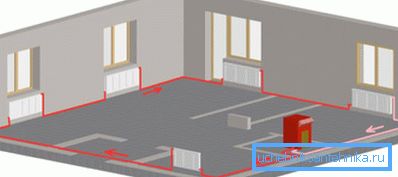
- two-pipe system - such circuits 2, one supplies hot water to the batteries, and the other takes it to the riser or collector.

To say uniquely one-pipe or two-pipe heating system is better impossible without a more detailed consideration of the structure of each of the heating systems. Indeed, when comparing, it is necessary to take into account not only cost indicators, but also durability, ease of use, efficiency, etc.
Single pipe heating system
The coolant in this case from the riser enters the supply pipeline and begins to move along the floor. It enters the radiator, heats it and is discharged back through the same pipe (see also the article Air heating of a country house: ideas for self-improvement).
That is, the cooled coolant is mixed with water in the pipe, reducing its temperature. At the end of the already cooled water is fed back to the boiler.
Strengths and weaknesses of one-pipe heating
The main complaint about this method of supplying coolant to radiators can be called the fact that the same pipe is both supply and discharge. Considering the fact that several batteries are connected to the pipe when laying horizontally across the floor, the heating efficiency decreases. The fact is that the temperature of the coolant decreases as it passes through the battery.
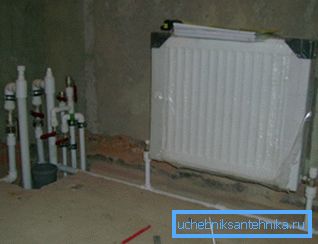
Note! If you are trying to connect 7-10 radiators to one pipe during installation on the floor, then the last few radiators will work with almost zero efficiency. Due to the cooling of the coolant, they will be barely warm.
On the other hand, the price of heating a dwelling organized according to such a scheme is much simpler, and the installation process itself is less labor intensive. Savings are achieved primarily due to lower need for materials.
The main question is whether the savings can outweigh the shortcomings voiced. It should also be noted that without upgrading one-pipe heating, you can forget about the flexible control of the microclimate in the house, all the batteries will heat up to a certain temperature and you can forget about the adjustment.
Heating improvements
You can get rid of one of the problems with your own hands with a minimum of effort and financial costs. To do this, you will have to install a bypass and integrate a thermostat into it, it will allow to regulate the flow of coolant into the radiator.
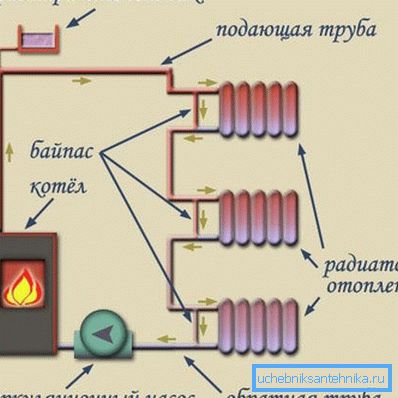
A bypass is simply a bypass section of a pipe, it is often installed on a pipeline so that the system does not stop working, for example, when repairing or replacing a section of pipe.
In the case of heating, the advantage is that:
- the built-in temperature controller will change the flow of coolant independently;
- even if one of the batteries fails in winter, the bypass will simply allow the damaged section of the pipe to be turned off.
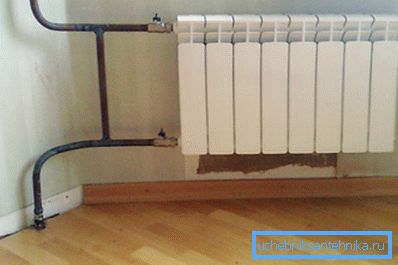
Two-pipe heating
In this case, already used 2 pipes - supply and discharge (return). So the flexibility of the system at a height. Each of the radiators works independently of the other, which only goes to the benefit of heating the house.
Features of two-pipe heating systems
When it comes to which heating system is better than single-pipe or two-pipe, usually the main argument is the possibility of flexible temperature control of each battery separately.
But the peculiarities of 2-pipe heating systems do not end there, it is worth mentioning that:
- hydrodynamic resistance is less;
- the cost of installation work in this case will be higher than that of a single-tube counterpart. The complexity of the work will also increase, because it will be necessary to correctly install approximately twice as many pipes.
However, judging by the popularity of twin-tube heating, the advantages outweigh the disadvantages. Such systems are used with almost no restrictions, 2-pipe schemes can be found both in private homes and in new high-rises.

Note! In high-rise buildings, it is recommended to adhere to the upper vertical wiring (for 2-pipe versions), in the case of 1-pipe heating organization, horizontal floor wiring will be optimal.
Comparison of wiring methods for single and double pipe heating systems
When using only one pipe, there are not so many variants of the installation scheme; you can choose:
- vertical layout - while all heating devices are connected to the riser;
- horizontal - it is used in cases when it is necessary to heat houses of a low number of floors, but with a large floor area. In this case, all the batteries are connected to each other.

Also pay attention to the method of connecting the heater. The nature of the movement of the coolant on the radiator, and hence its heating, depends on this.
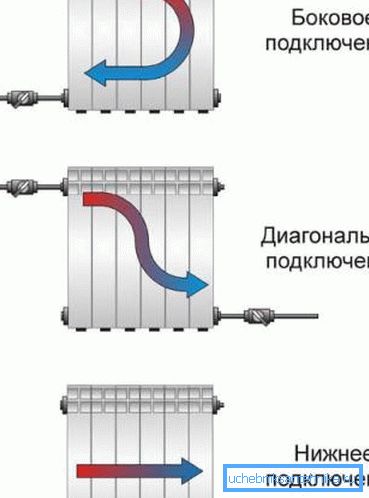
Note! For both options is quite acute problem of air traffic jams.
For 2-pipe heating wiring options can be listed more:
- upper wiring is relevant for the natural circulation of the coolant;
- lower wiring - suitable if the circulation is provided by a circulation pump;
- It is possible to single out a subspecies of the “star” type of wiring - from the collector to each radiator there goes its own supply pipeline and its own return.
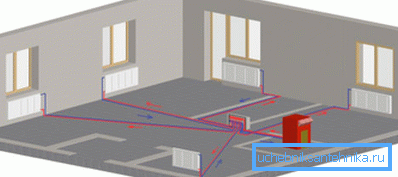
As for the installation technology, the instruction in general looks like this:
- sets the boiler;
- the supply pipe is laid in accordance with the project;
- radiators are installed;
- the feed pipe is connected to the radiators, for one-pipe systems it is best to install a bypass and a thermostat for it at this stage;
- the return pipe is connected to the boiler, thereby closing the heating circuit. You will also need to install a surge tank at the highest point.
Note! The circulation pump is installed exactly at the junction of the pipeline with the coolant already cooled to the boiler. This is due to the fact that at high temperatures the pump will quickly wear out.

What to choose
There is no single answer to which option is better - a one-pipe heating system or a two-pipe one.
It all depends on:
- budget - if there are no restrictions on available funds, it is better not to save money and stay on the 2-pipe version;
- appointments - if you need to heat a small country house, then there is no point in messing around with quite expensive 2-pipe heating.
Briefly, the result can be summarized as follows:
- 2-pipe heating is more expensive, but more efficient and easier to operate;
- 1-pipe is cheaper, but it is less efficient, and problems may arise during operation.
Summarizing
Many when choosing the type of heating system, the main criterion consider the cost, which is not quite true. It is better to make a choice consciously, based on the characteristics of the heating operation. The proposed material will help the doubters finally decide on the choice of the heating system.
In the video, the difference between these heating systems is shown more clearly.